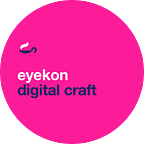Good Research Doesn’t Have to Be Expensive and Time Consuming.
Do you have a user-centered approach, but no budget or time for research? Try Minimal User Experience Reserach (MUxR) and learn how to efficiently create a solid foundation for successful digital projects. (w/ templates)
By Marco Lüthi, Interaction Designer
The Research Dilemma
We make things for people, and therefore should understand these people the best we can, to make the best products we can. Even if the term “user-centered design” is now commonplace, unfortunately, all too often there are still no concrete steps taken to understand the users.
As we see it at Eyekon, the reasons for this are threefold:
- Why research? You assume that you already know your customers best anyway.
- Where to start? You don’t know how to correctly apply user research methodology or where to start.
- How to pay? Even if knowledge and willingness is available, budget isn’t.
The Solution? Our MUxR Set
This has led us to develop the “Minimum User Experience Research” set: a reduced collection of proven user research methodologies that enables our clients to better understand their customers — facilitating a solid foundation for great projects.
What does MUxR entail? Just a couple hours. What is the secret magic behind it? None, actually. We’ve reviewed the possible approaches and tools and used the resulting understanding as a basis for the creation of the MUxR set. Like the ouroboros snake that bites its own tail, we have applied “minimal user research” to create our own MUxR set — which we now want to share with you.
Please note, templates are currently only available in German.
Just Get Started!
User Research methodologies are many and varied, but one thing that unifies them is that there is essentially no wrong you can do. The crucial aspect is the process of doing, thinking and putting thoughts on paper to share with others, no matter what methods you use. But yes, some methods are harder to understand and implement than others. MUxR itself is a set of simple-to-understand methods, which are: Personas, User Stories, User Journeys & Competitive Analysis.
Each method builds from the one preceding it (from the bottom to the top). First we need to understand who we are designing for (Persona) and describe how they interact with our product (User Stories). These small interactions lead towards a journey throughout the whole product experience (User Journey) and finally we compare how our product competes against our competition (Competitive Analysis) to see if we have an edge. Of course, the process can be extended, but with these few methods alone, we gain a good overview of the big picture and can thus offer the user something really specific.
Determine Costs Yourself
Conducting surveys and workshops can cost a lot of time and resources. One way to minimize these costs is to do these tasks yourself — with your own skills and at your own pace, but while still using an expert template. You know your customers and their needs. You know how your product is used. You know your competition. You have ideas. All you need to do is communicate and synthesize your ideas to share with others, and this is exactly what the MUxR facilitates — with simple templates for you to educate stakeholders, yourself, and partners, in order to better cooperate and create truly (minimal) user-centered concepts.
At Eyekon we have been using the MUxR-Set for several years. It has often helped us to develop innovative, user-centered products. For all our German speaking friends: if you are interested in using our MUxR set yourself, we have provided our templates for you to download here. And for more information about our user-centered approach, feel free to contact us or subscribe to our newsletter (in German).
